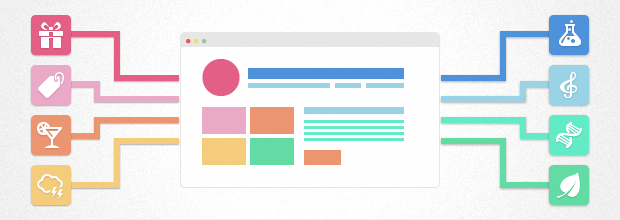
In the business world today, content marketing is a hot topic. It seems like everyone, especially in the B2B arena, is jumping on the content marketing bandwagon. Indeed, content marketing – done correctly, can be a very effective way to attract new leads.
It can help you win clients. But a lot of marketing content does not have the intended effect its creators had hoped for – far from it! A lot of content adds to the very problem it was intended to solve. What problem is that? Noise!
Before content marketing became such a popular concept, our culture was drowning in a sea of advertising and marketing. Content marketing was hailed as a solution to this vexing problem. What happened was that much of this flood of content became dismissively viewed as noise.
And the problem is growing worse as more and more companies produce more and more content, especially when they don’t understand how to produce content that will engage their target audience.
Today, let’s talk about how you can identify the content topics most likely to resonate with your audience, that is, your potential customers. Let’s talk about why this is so important to your content marketing success. Let’s discuss some tools you can leverage to help you become a more successful content marketer.
We’ll also talk about writing more compelling, persuasive, engaging content once you’ve identified the topics you want to write about and share with your audience.
First Things First
Doesn’t it make sense that before you can identify the content topics that will resonate with your potential customer, you need to understand him in detail? Of course it does! How can you write a white paper, an email marketing message or produce a webinar that will make prospects sit up and take notice if you don’t first understand their fears, frustrations, goals, dreams and so on?
Before you write the first piece of content, get a minute, detailed accurate understanding of whom you are writing to. Keep this customer profile in the forefront of your mind as you produce your content. Use the details of it to write in such a way that your messages will speak powerfully to your readers, in a way they view as relevant to their wants and needs.
Once you have your detailed customer profile, use it to help you write engaging content that will grab and keep your readers’ attention and make them want to learn more about how you can help them. Write content that will, especially if your are a B2B marketer, make them want more of your content.
Here’s how you can ratchet up the persuasiveness and engagement factor of your content even more: find out from your target audience what they want you to write about. For example, let’s say you are writing content on physical fitness training, and you have a large email list that you regularly stay in contact with.
Want To Find Out? Ask!
You want to keep them happy with the information you offer them. You want to keep them interested and engaged. You want to keep them involved in your virtual community. And you want to sell more of your products and services to them. So what can you do? It’s simple: Ask them what they would like you to write about.
Send out an email with a link to a brief online survey you’ve put together. In it, ask them what specific topics they want to get your input on. Make a list of the top several items from the survey, and write informative, engaging, persuasive content about them.
Surveys can be very useful; they can help you identify the content topics your audience wants to read about. You can conduct them with a web-based survey tool like Survey Monkey.
Take a look at what your competitors are writing about. Also, determine what they are not writing about. After studying your detailed customer profile, brainstorm on ideas you are confident your audience wants to hear about, ideas that your competitors aren’t addressing, and write about them.
“Hang Out” With Your Audience
Spend time with your target audience, in person if possible, but more likely online. Visit their social media profiles, read their blogs, join the discussion forums and LinkedIn groups they are members of. Monitor their discussions and social media posts to get a sense of what’s on their minds related to your niche. Write informative, problem-solving, even entertaining content that will address these issues.
Always judge content ideas by your customer profile. There are certain topics likely to resonate with your readers in a big way and others that will cause them to yawn and lose interest. Using the example of physical fitness and exercise again, if your audience is a dedicated group of hardcore strength trainers whose goal is to see how much weight they can lift and is passionate about growing big muscles, chances are they will have little or no interest in an article on marathon running or triathlon training.
Give Them What They Want!
Don’t try to force feed content ideas to your audience just because they are popular in other circles. Don’t try to persuade a 280 lb. elite weightlifter to be interested in the same content that a 140 lb. triathlete would devour. Don’t tell him or imply that he should be interested in reading about long distance racing. Give the weightlifter what he wants – useful information that will help him get stronger.
Writing That Helps You Produce More Persuasive, Engaging Content
Congratulations! You’ve taken the time and effort to painstakingly assemble your ideal customer profile. You done the detective work to find out what topics will likely be a content home run with your audience. But don’t rest easy yet. Your work is only partially done. You can still lose your audience to your competitors.
How? By writing content that bores them. By writing content that focuses on your company, products and industry awards rather than on them, their needs, their wants, their problems and your solutions.
We’ve already talked extensively in this blog about how to write persuasive sales copy. This article, will give you a primer on the basics of effective copywriting. Today, we’ve focused so far on content more than copywriting. But, at some point, content, in order to be an effective marketing tool, needs to persuade. It needs to include some of the same elements that make first-rate sales copy so powerful.
“…if all you do is give away free content, you are not going to close many sales.” Bob Bly
Bob Bly is one of the world’s most well-respected direct response copywriters. He’s also a very accomplished and successful content marketer. He contends that content marketing needs to do more than just educate; he says it needs to also persuade the reader to choose the company’s product over other alternatives, including the alternative of doing nothing.
This blog has other articles that talk about effective copywriting and give tips that can make your content much more engaging, so we won’t go into detail here. But keep in mind that contrary to what some content marketers mistakenly believe, content marketing needs to do more than just educate and inform. It needs to persuade. It needs the boost that only solid copywriting can give it.
An Important Content Marketing Tool
In your online marketing, as you attempt to “nudge” prospects forward in their buying journey, especially in the B2B world, you need to continue offering them relevant content that educates and informs them, content that engages them, and content with strong copywriting that ultimately persuades them. Whether the final sale will be made by the copy online, or by a sales rep on the phone or in person, you need persuasive written words to help you make your case.
And you need landing pages. Are you a B2B content marketer? You need landing pages to help you “sell” website visitors on your content offerings. Do you run an online E-Commerce store? You need to leverage the power and effectiveness of great landing pages as you attempt that often tricky process of persuading your potential customer to “make the leap” from shopper to buyer.
But whether you are a B2B marketer, or you are running an E-Commerce store, you’re busy, maybe even overwhelmed, trying to keep up with the demands of your day-to-day schedule. You do not want to try and set up a landing page “the old fashioned way”! You don’t want the hassle and frustration of learning and messing with programming code or struggling to understand an outdated landing page program that burdens you with a lousy user experience.
You want a turnkey, “out-of-the-box” landing page platform that’s easy to set up and manage. You want a landing page platform that’s engineered to help you increase your conversion rates – one that helps you gain more followers for the content you’ve worked so hard to produce. You want landing pages that help you win more customers.
Happy Marketing!

